May 2015 April 2015 >>
Blog of Jack and Jude
explorers, authors, photographers & videographers
NOT FAIR ! We’re freezing in Tassie when they publish our Coral Sea Guide
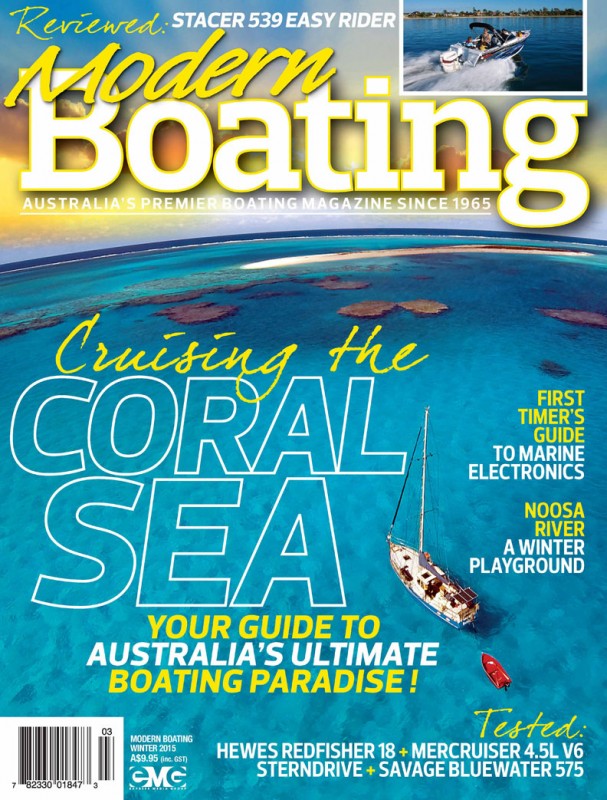 If winter has struck, find this mag, balmy Coral Sea island on the cover – and our boat, Banyandah, with little Red floating astern. Inside our feature of where to go for the best in the Coral Sea. Beaut photos, A complete Guide. Or watch our Coral Sea DVD
If winter has struck, find this mag, balmy Coral Sea island on the cover – and our boat, Banyandah, with little Red floating astern. Inside our feature of where to go for the best in the Coral Sea. Beaut photos, A complete Guide. Or watch our Coral Sea DVD
Wish we were there, in boardshorts instead on wool pants and jumper.
Third Time Lucky
We’ve just come out of the Gordon River yet again after a third look for that elusive bridge, or that’s the excuse we have used each time to immerse ourselves in some of Earth’s greatest rainforest. In addition to enjoying the beauty and adventure, we have been on a mission to try and find a lost historical track through the SW forest that leads to an immense buttongrass plain. Daunting is a mild description of the task.
This time we took our base camp deep into rich forest and set it up next to two Huon pines nearly a thousand year old. From there, every day for three days on the trot we pushed further into thick growth, tagging, and clearing enough for an experienced person to follow. Maybe next season there will be others who can open the track up so that students and less able folk can have the experience. We’re talking about the old shoe road that ran from Goulds Landing to the Rocky Sprent. Cut in 1860 when the state’s Geological Surveyor Charles Gould first explored the west for resources, it became the lifeline for the piners, and then the supply link for Tasmania Hydro.
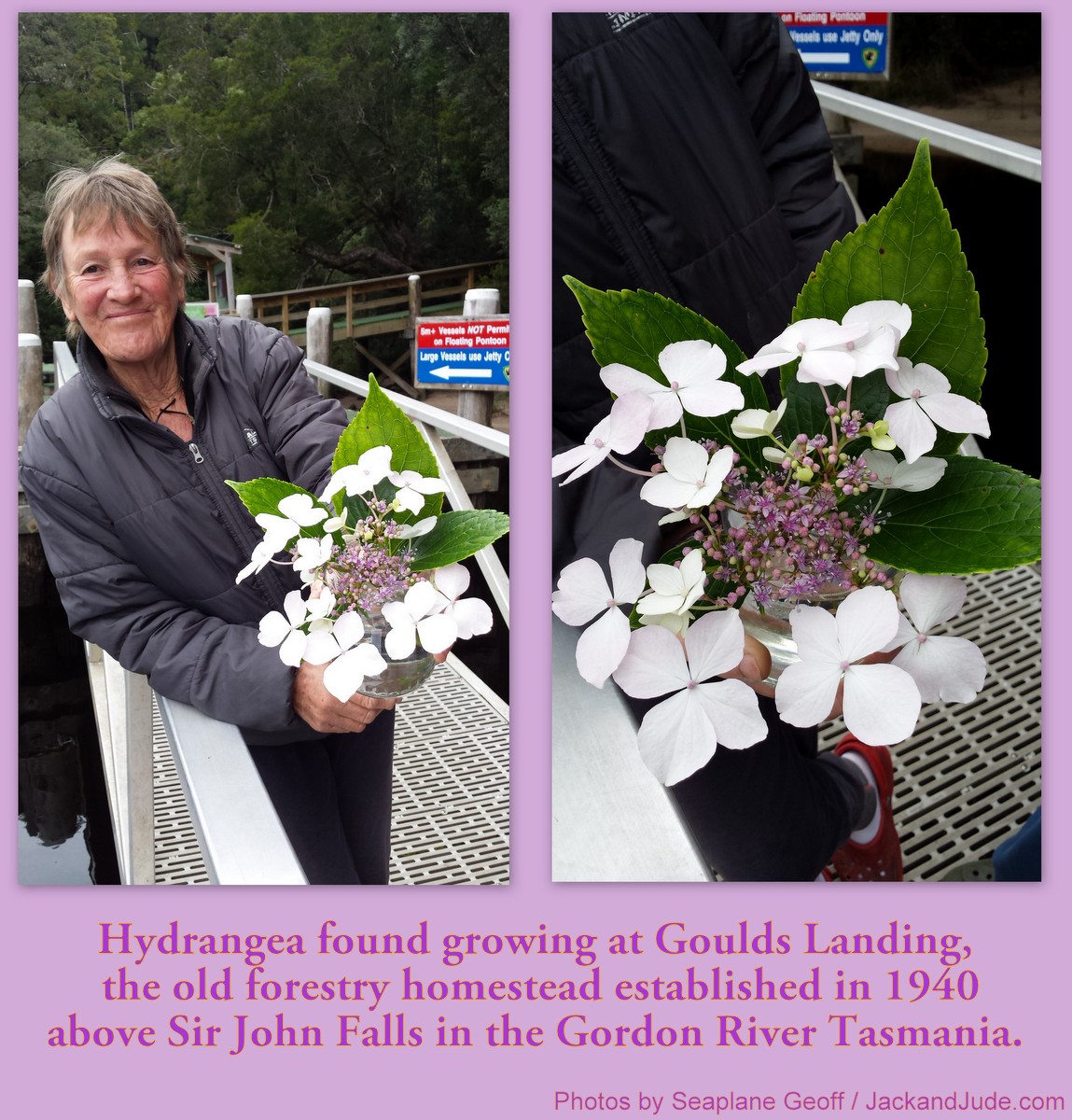 Before starting this journey, Jude’s seventieth whizzed past in one fun night, celebrated with west coast friends then next day a rather large high pressure cell appeared on our weather charts. Hoping it would produce perfect winds to sail back to South Australia, we began preparing Banyandah for her Southern Ocean voyage. A last round of socials added fun between chores while the high pressure bubble edged closer. Meanwhile, racing up from below sixty south, a deepening low pressure cell with a whip shaped cold front menacingly swept towards Tasmania’s west coast.
Before starting this journey, Jude’s seventieth whizzed past in one fun night, celebrated with west coast friends then next day a rather large high pressure cell appeared on our weather charts. Hoping it would produce perfect winds to sail back to South Australia, we began preparing Banyandah for her Southern Ocean voyage. A last round of socials added fun between chores while the high pressure bubble edged closer. Meanwhile, racing up from below sixty south, a deepening low pressure cell with a whip shaped cold front menacingly swept towards Tasmania’s west coast.
Then from out the blue our phone rang one morning. “Hi Jack. Will you guys be in Tasmania next Thursday?” a friendly voice we’d had fun with in the past asked. Stammering a bit I laid out the facts. “Actually it looks like we sail the day before. Why?”
Dave and Jenny had been the caretakers maintaining the fishing resort on Dirk Hartog Island when we happened along in 2007. Perched on the outer edge of Western Australia’s Shark Bay, it’s where the first European landed in 1616. Dave, an expert off road handler, gave us a memorable tour over mountainous sand dunes to steep surf torn cliffs that will always live vividly in our hall of fame. Over the years we’ve had other fun encounters that have irrevocably entwined our lives. Nevertheless the weather gods must not be ignored. The Southern Ocean must be respected.
The gods love having fun with us mere mortals as we dabble on Earth, changing climate. Wondering whether we humans will ever get it together and cohabitate with all life must have brought on a particularly boring moment because all of a sudden the whip like front began pushing up mountainous waves. Geez! 10 to 13 metre monsters were coming to pound west Tasmania’s shores, and worse, the wind looked like ending before it even got going. Yiks! No wind and monstrous seas must have seemed a bad idea because I had one of those sleepless nights living the voyage and woke up not liking it one bit. So next morning I’m phoning Jenny and Dave suggesting we meet at the last stop the local tour boat makes in the Gordon River. Jude knew what was in my mind – yet another excursion up the Gordon to look for that elusive bridge. She was keen too. And why not? If it would be windless at sea, it’d be dry and lovely in the forest following that whip of bad weather. Even better, I figured the whip preceding the deluge would power us down harbour. So lickety-split, we had a plan.
Within twenty-four hours we were alongside the empty dock at Sir John Falls feeling like we were visiting an old friend. We’d spent half the summer alongside this magical lonely outpost and easily imagined being there forever – that is, if the water wasn’t so dang cold. For sure the river was ours. No one comes up this late in April. The Franklin rafting tours are over and Trevor’s Stormbreaker season ended the week before.
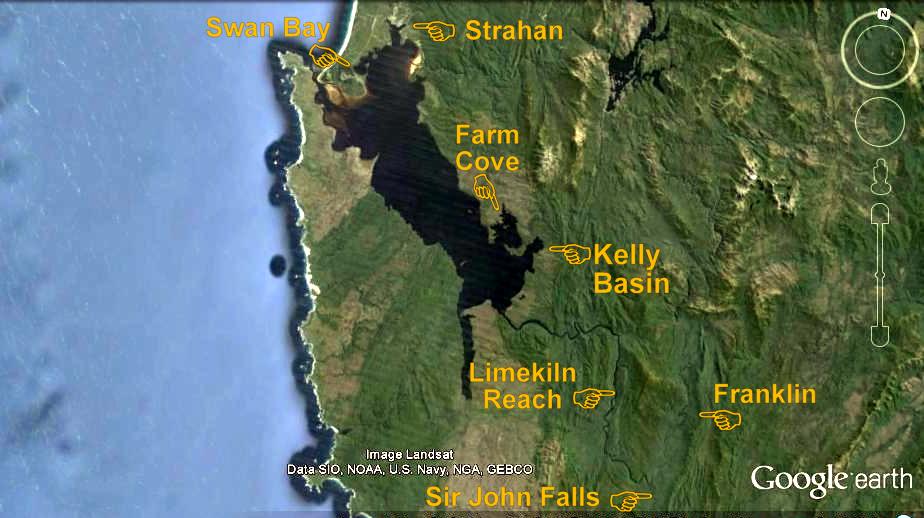
A massive amount of equipment and supplies began to pile up as our two person Macpac Celeste tent, down feather sleeping bags, kitchen and provisions were dug out. Jack says I’m a pro, knowing just what to bring. My menu is simple. Breakfast cereal with an assortment of dried fruit. Lunches are based on a choice of crackers spread with a selection of hard and soft cheese, peanut butter, tiny tins of red salmon or flavoured tuna. We’ll often have a warming soup entrée upon getting back to camp in our sweat soaked walking shirts, sipping the hot drinks while keeping on the move so they dry a bit while we make preparations for the night. Our dinner is basically centred round a packaged pasta meal or couscous with additives like tuna, nuts, or lentils, or for Jack sliced salami. Veggies feature in the evening meal. A few bits of fresh broccoli, sweet potato, zucchini, or carrot go a long way. And I have a way of boiling up minute noodles then frying them with veggies and a fresh egg, carried in a plastic tub, before adding soy or sliced chilli. Simple and yummy. Plus plenty of hot beverages and the inevitable cask of red wine to drown the day’s pains or celebrate our achievements.
We eat well but we also look after our safety with a passion. Why spoil the fun with a medical emergency that might risk our lives, or the lives of others sent to rescue ill prepared explorers. We carry a custom built bush medical kit developed over our many years of adventuring together. This habit began from a wedding gift, a comprehensive first aid kit put together by doctor friends at the hospital where I trained when we took off overland on our honeymoon through Africa. This mini kit goes with us whenever we leave the boat in isolated places and it saved me when I fell and broke my leg in the Kimberley. There are some very powerful drugs in that small watertight container, as well as sutures, saline, burn ointment, and much more. And a strong crepe bandage is always stuffed somewhere handy. We always carry a personal location beacon and this trip Jack was carrying our Yellow-brick which also transmits our position and can send messages via the Iridium Satellite network. He thought it would be cute to see our forest positions displayed on our website, and each night after safely getting back to our camp we sent the kids a short message. With such modern technology, our grandkids can see where nanni and poppy go bush and it enthuses them about next winter’s camping with us.
Our mountain of supplies nearly doubled when we added our clobber. The terrain is wet and cold so we took multiple layers of mainly wool jumpers and shirts, a change of clothes for evening and a change out of boots. What’s missing? Oh yes, navigation gear; maps, two GPS, and a compass. Plus a handsaw to trim a bit around the camp and along the track.
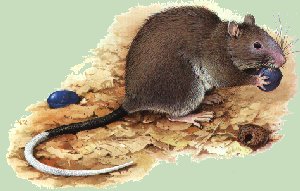 Getting off to a good start is always top priority, but we weren’t off quickly this time as we had an unwelcome visitor in the night. While we slept aft, a rodent hip hopped down forward. Could have been a white tailed water rat. Who knows! But the critter left behind lots of scat while it tasted the bag of cereal, finding it to its liking. It also loved the candy selection lying on the settee because it devoured half a Mars Bar, leaving broad rough teeth marks in the chocolate. This brought up a real dilemma. We surely did not want to lock a hungry rodent inside Banyandah. They’ll sample just about anything, wiring, hoses, wood, as we found out long ago when we left our lady tied to a jetty in Borneo before flying off to the USA for a family visit. Four months later we returned to near disaster. Rats had swum to our anchor lines, climbed aboard, gnawed through the dorade vent mesh and had fallen into our main saloon. When opening the cabin doors, the stench and thick layer of poo absolutely shattered us. One demon even attacked our son when he went below. That wasn’t going to happen again, so every floor board was lifted and torches probed every dark corner searching for telltale scat. In the end, with some lingering uncertainty, we loaded our supplies and locked up our baby.
Getting off to a good start is always top priority, but we weren’t off quickly this time as we had an unwelcome visitor in the night. While we slept aft, a rodent hip hopped down forward. Could have been a white tailed water rat. Who knows! But the critter left behind lots of scat while it tasted the bag of cereal, finding it to its liking. It also loved the candy selection lying on the settee because it devoured half a Mars Bar, leaving broad rough teeth marks in the chocolate. This brought up a real dilemma. We surely did not want to lock a hungry rodent inside Banyandah. They’ll sample just about anything, wiring, hoses, wood, as we found out long ago when we left our lady tied to a jetty in Borneo before flying off to the USA for a family visit. Four months later we returned to near disaster. Rats had swum to our anchor lines, climbed aboard, gnawed through the dorade vent mesh and had fallen into our main saloon. When opening the cabin doors, the stench and thick layer of poo absolutely shattered us. One demon even attacked our son when he went below. That wasn’t going to happen again, so every floor board was lifted and torches probed every dark corner searching for telltale scat. In the end, with some lingering uncertainty, we loaded our supplies and locked up our baby.
To gain access to the forest we first had to load our gear into Little Red to cross the flow of Cataract Creek where it enters the Gordon. Years ago, the jetty ran across this narrow bit connecting it to the track leading to the Forestry home site. Locals tell us an ultra conservative Ranger wanted to lock up the entire forest and let Nature reclaim the lot, and had the jetty rebuilt without the connection to the historical home site. Personally we think if you lock up wilderness so no one can connect with Nature, more harmful economic decisions will likely be made. Don’t kill the adventure in us. Enough has been wiped out already. Let adventurous families and students in. In fact provide an informed guide. Let our youth feel the majesty and wonder of Nature and then they’ll respect and better protect it. It’s nonsense to think this area would ever be over used like the more accessible parts of Tasmania.
Getting our huge backpacks, Jack’s now weighing close to 20 kg, out the dinghy and onto the steep slope set off warning bells. In fact when lifting it onto his shoulders, he and his black brute nearly tumbled into the river. It was not only too tall, but obviously top heavy. Something set to cause him trouble. Mine’s more squat, nevertheless I keep my chest strap tight so as not to topple sideways.
While slowly climbing the eroded track leading to the home site the recognizable high pitched engine noise from Geoff’s floatplane swept down the river below us. This prompted us to drop our loads and return to give Geoff a heads up. We’d left a note for him taped to our cockpit window, but to be doubly sure he knew our plans we went back within earshot and Jack called out after his four passengers had disembarked. While they scanned the thick foliage for our voices, Geoff saw us and waved, then recovered the note that included a GPS position for our camp and where we’d left the keys to Banyandah. Throwing up his arms with an almighty thumbs up he shouted “good luck,” and we took off to retrieve our heavy loads.
I managed the uneven track fairly well. My walking stick is a steadying third leg and useful for testing underfoot firmness. What hampered us both were the numerous tree falls across the shoe road. The first one hung Jack up, his pack straps cutting deeply into his shoulders. To break free he had to drop to his knees then waddle under the limbs like a heavily laden duck. I didn’t fare better. Regaining our feet took heaps of effort now that our muscles have declined a titch in our mature years. I’m pretty sure this caused alarm in both of us as we wondered if we’d bitten off more than we could tackle. Nonsense! Just need to readjust our speed, and knuckle down to a laborious trudge up the steeper parts, and focus on the upcoming flatter bits previously cleared. That sums up our outward journey. Amazingly we accomplished the two to three kilometre walk to our chosen campsite in under three hours.
While Jude established her kitchen, testing it by making a hot cup of tea, I sorted a flat spot for our tent next to the two mature Huon Pines. Removing a couple of limbs of Horizontal blocking access across the site quickly opened up the area. Then by erecting a large fly provided bag storage space and shelter from dew or rain. It was really cosy. Meanwhile, just a short stroll through the bush Jude found a small pool of creek water, stained tea colour by the buttongrass tannin.
It took all afternoon to do this, then after eating early, soon after dark we crawled somewhat exhausted into our warm bags. Deep in rainforest with no moon it’s intensely dark. Scary dark. I awoke in the night hearing the thump of a wallaby, the rustle of some smaller creatures, then more alarmingly the yelp of something that was answered by the yelp of another, like a pack of hungry young Tassie Devils. Nah, I kept telling myself. Devils don’t attack! Yet a vision of the nasty canines in Avatar ran round my head while my bladder kept prodding me. And when I looked at that wall of absolute black I remembered the old fellow found some years ago in Kelly Basin. Only bits of cloth and the top of his head were found. Jude tells me she also heard the wallabies, and a Southern Boobook owl book-book hoot, and next day delighted in seeing one up close.
When surrounded by closed-forest blackness it’s not easy to tell when the new day is coming. But the first titch of lightness on the tent’s sidewall had me up with my headlamp blazing every which way. Within thirty minutes I’d made tea for my lady and was on my second coffee with a bowl of cold cereal in front of me. Within an hour we were in our bush gear excited to blaze a new trail.
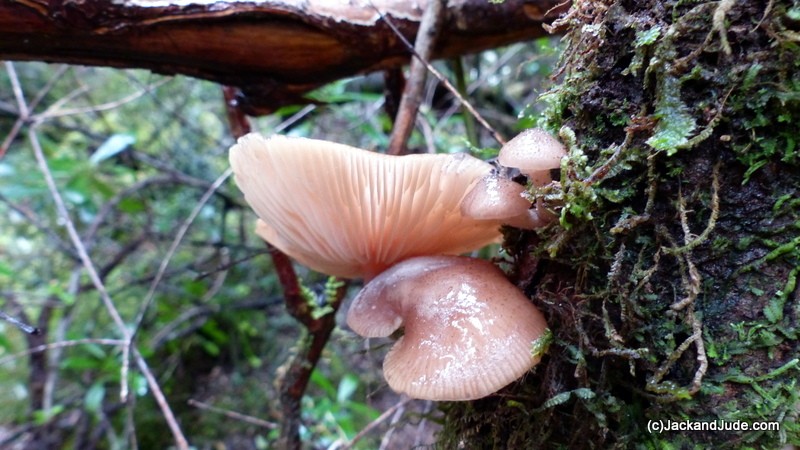 It’s so beautiful when totally surrounded by Nature that even the pesky wetness that’s everywhere fades into insignificance. Colourful mushrooms pop up on the mossy limbs and the ambience is calming. Here creation lives together, dependent on the other, a confused but somehow orderly Earth, immensely reassuring in man’s crazy world. Fabulous Nature carrying on without one thought to our madness.
It’s so beautiful when totally surrounded by Nature that even the pesky wetness that’s everywhere fades into insignificance. Colourful mushrooms pop up on the mossy limbs and the ambience is calming. Here creation lives together, dependent on the other, a confused but somehow orderly Earth, immensely reassuring in man’s crazy world. Fabulous Nature carrying on without one thought to our madness.
In a previous trip we had found and tagged a further two hundred metres of track, but knew from there on we’d have to search for hints of where the historical track ran. Nature marches on relentlessly, as it has since this track had last been commercially used in the 70s. Look to your own garden for confirmation. Then quadruple that untended growth and add tree fall.
At waypoint 348LAS, our last tape, there are two massive Huon Pine stumps overgrown with rich green moss thickly covering what is still hard viable timber. Jack pushed into the forest beyond these stumps and eventually found what to his eyes had been a track through mature Manuka, also known as tea tree. Their trunks dripping with shedding bark was reasonably clear beneath them. Drier now, the wet moss had suddenly ended. Without our knowing, those two massive Huon Pine stumps were the last Huons we’d see. Making a tunnel running through the Manuka, Jack followed his compass while I tied bits of pink ribbon at strategic points within sight of the last so we’d more easily find our way home.
We’d love to report that the first day took us all the way to our destination but that was not so. We did pass through deep wet gullies, climbed small ridges, got foiled by a creek chasm, but eventually ate a late lunch under an enormous Eucalyptus that probably lost its head during one of those famous west coast storms. Dubbed Big Headless, he became that day’s turnaround waypoint. We’d had a grand day tight rope walking slippery wet rotting logs, got lost more than once, saw hundreds of the most gorgeously coloured fungi, and greatly enjoyed the adventure of exploring and mapping a mostly open passage that took us halfway to our target.
Which brings up the question of where were we trying to get? And how did all this begin?
Well, we’re passionate about re-finding these old historic tracks before they’re completely obliterated, particularly as Parks’ funding has dwindled to such low levels that minor attractions are ignored. A few years ago a team of us cleared the track that brought Sir John and Lady Jane Franklin across from the east coast in 1842, and Parks gave us approval to maintain it. A really smart decision. With several locals keen to preserve these, we’ve formed an informal group hoping to encourage and teach bush skills and folklore to others.
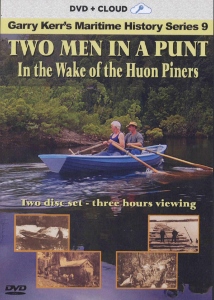 Just after returning from the Hobart Wooden Boat Festival in early February, we had a dinner party on board for friend Ronnie. He’s a patriarch of one of Strahan’s oldest families who came here from Victoria in 1900 to harvest Huon and King Billy Pines. A generous and multitalented gentleman, nothing is too much trouble for him. He can build timber vessels, work metal, and drive all sorts of craft. But that’s not all. He knows the bush. Knows the Huon Piners history. Knows all the families involved and where the old ones had their camps. A down to earth bloke, he’s a recent star in ‘Two Men in a Punt’ Garry Kerr’s latest movie which we helped produce fifteen months ago right here in the Gordon.
Just after returning from the Hobart Wooden Boat Festival in early February, we had a dinner party on board for friend Ronnie. He’s a patriarch of one of Strahan’s oldest families who came here from Victoria in 1900 to harvest Huon and King Billy Pines. A generous and multitalented gentleman, nothing is too much trouble for him. He can build timber vessels, work metal, and drive all sorts of craft. But that’s not all. He knows the bush. Knows the Huon Piners history. Knows all the families involved and where the old ones had their camps. A down to earth bloke, he’s a recent star in ‘Two Men in a Punt’ Garry Kerr’s latest movie which we helped produce fifteen months ago right here in the Gordon.
Ronnie likes to talk about the rich history of this area, his admiration of those bygone days pouring out, story after story. Over dinner he began talking about the old shoe road that ran from Goulds Landing to his family’s leases at the Rocky Sprent. Cut in 1860 when the state’s Geological Surveyor Charles Gould first explored the west for resources, it became the lifeline for the piners, and then the supply link for Tasmania Hydro. Ronnie’s ears shot up when Jack told him that he’d seen obvious remnants of the track where it ran through the buttongrass plains in Google Earth photos.
We were getting set to wander down harbour, so exploring the home site and Goulds track went to the top of our list. That must have inspired Ronnie because next morning, saying he’d been up most of the night, he returned with a list of track waypoints he’d established while examining the Google Earth Satellite images. Brimming with suppressed excitement, he also claimed to have found a bridge! Together we looked at his screenshots and had to agree that there was something which might be a bridge across a small creek, heavily overgrown as it would be after sixty years in a wet forest. Finding a bridge would create a destination, a focal point, so we were keen to give that a go.
We had never been up to the Forestry home site. Not sure why. Maybe we lost interest when we heard that a lady off another yacht got lost in the jungle above Sir John Falls. Imagining her calls echoing through the night forest makes a lasting impression. Add the fact that it’s so hard to get onto the overgrown track now that the jetty has been rebuilt. Across Cataract Creek, it’s dinghy access then a clamber onto a steep heavily vegetated slope.
Our first trip tied alongside Sir John Falls started badly by choosing the wrong landing spot. A rotten branch broke and Jude nearly fell in. Somehow we managed the track up, squishing through mud under fallen trees and pushing through thickly overgrown bracken to find the old house site. From the moment we entered that area we became entranced by the huge amount of history we’d read or been told about. In the stillness of that lonely, beautiful location we could hear mustered horses neigh, men calling to each other while chaff packs on horsebacks swayed away to start along the shoe-road taking supplies to the piners. With some effort, amongst the fallen trees we found the old shoe road slightly up the shallow bowl, and after crawling under fallen trees yet again, managed a few hundred metres to gaze back and instantly have our imaginations run riot. Others should have that experience. The interplay between lush Nature and man’s efforts strongly impressed us. In a vision we saw the track cleared to become an easy gradient walk through some of Earth’s grandest rainforest.
The Bridge? Well! On the last day we finally got to its position as shown on Google Earth. Jude and I had suspected long before arriving in that creek that there would not be a bridge. We saw that there were no trees to harvest after those last two massive Huon stumps. Therefore the track was no longer a shoe road to drag logs along, but rather a packhorse track. Packhorses would have walked across small creeks. The lush thick rainforest about the stream would obstruct a satellite presenting a concise image, so to be certain, we searched up and downstream for a hundred metres, not sighting anything unnatural. So the question has been resolved. No bridge.
Nevertheless we have established a route through a large difficult forest to a creek where just on the other side begins a massively large buttongrass plain that runs practically all the way to the Rocky Sprent River. Trees do not grow on a buttongrass plain and the sky is wide open, making travel considerably easier. Now that’s a destination worth considering for a future adventure. We also had a grand time together, tackling adversity, recording nearly a thousand images and several hours of HD video, and have memories to last forever and we learned heaps. We love Earth all the more for it. What a summer this has been.
To see how this adventure began – Read April’s blog
Search for Piner’s Shoe Road and Continuing The Hunt
PHOTOS FROM THE TWO EARLIER TRIPS
PLAYLIST OF ALL CAMPTREK VIDEOS HERE


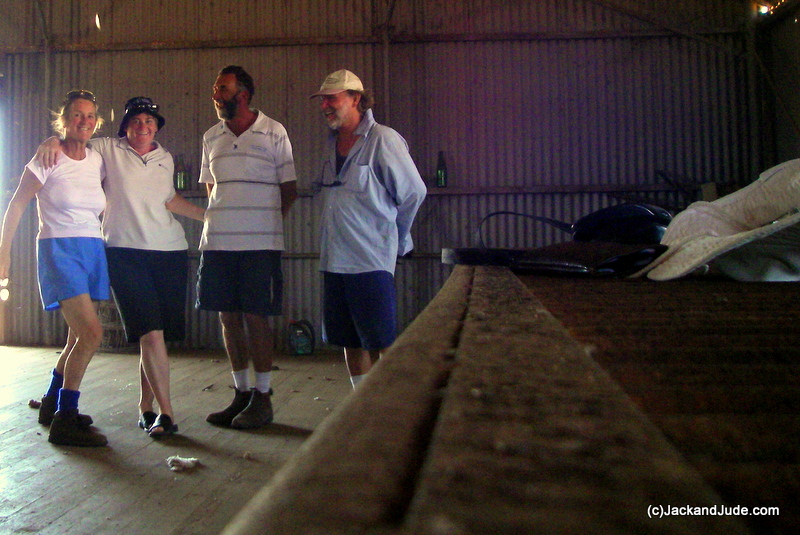
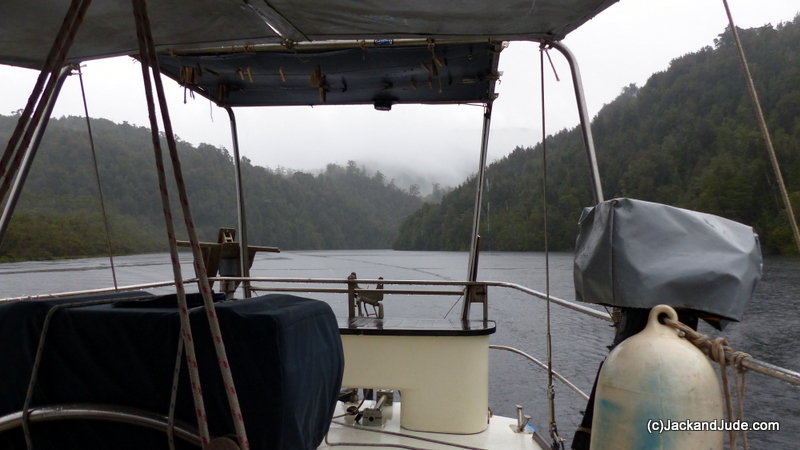
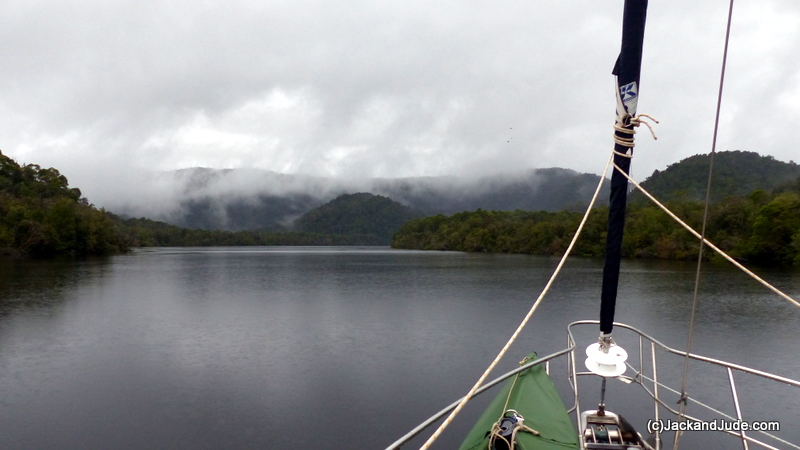

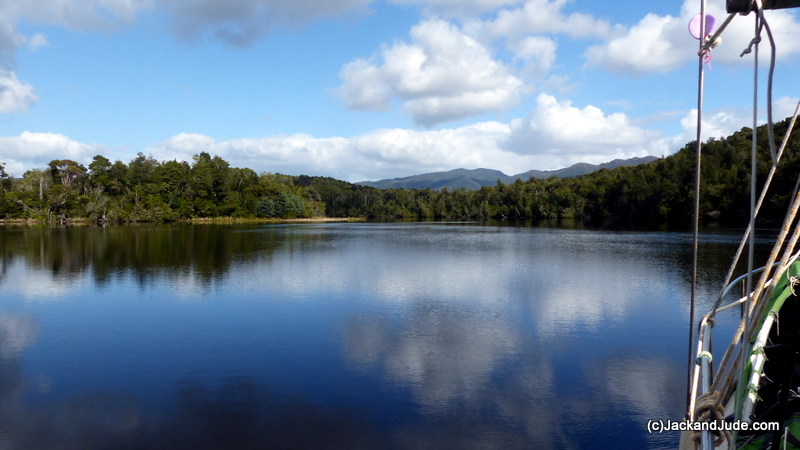

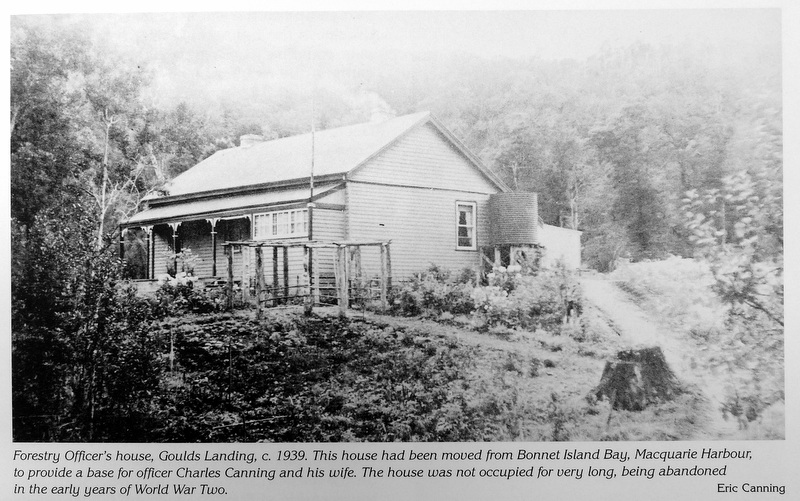
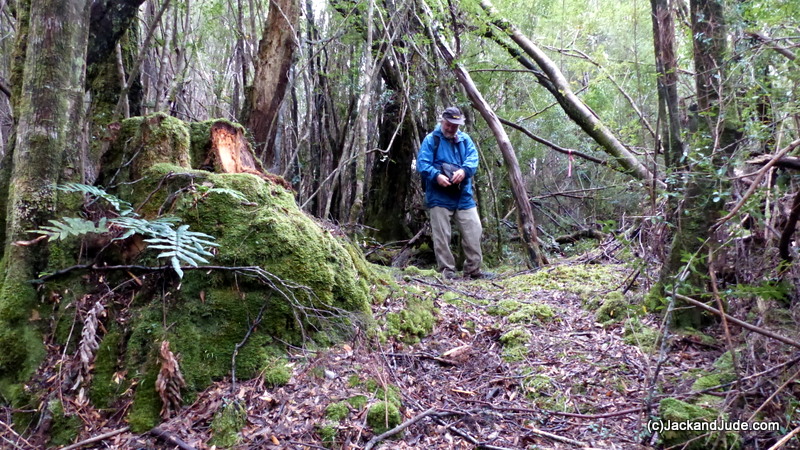

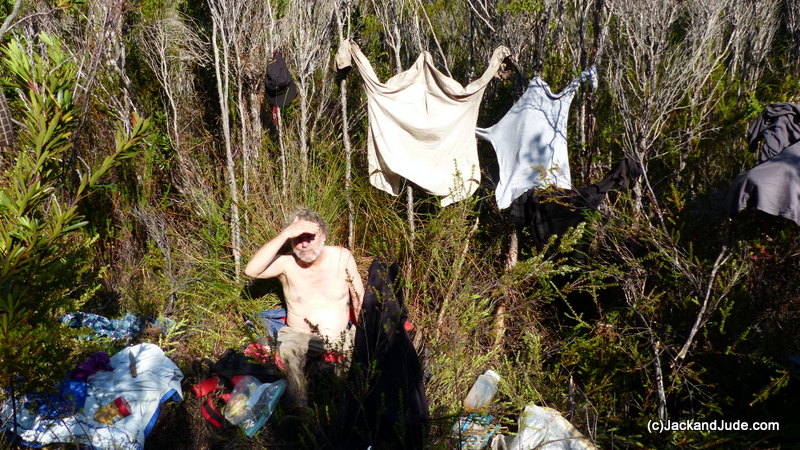

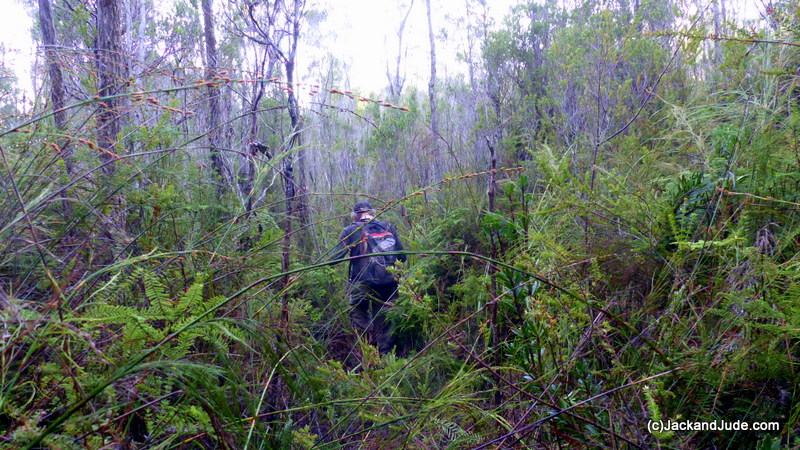
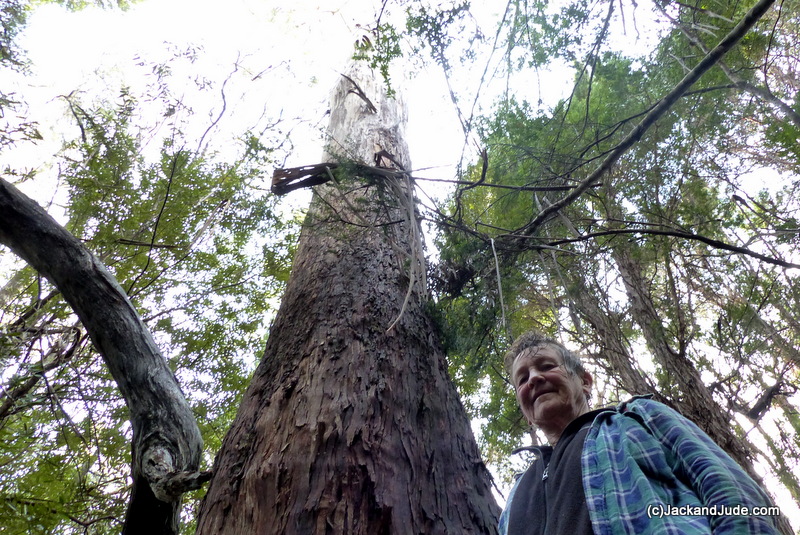
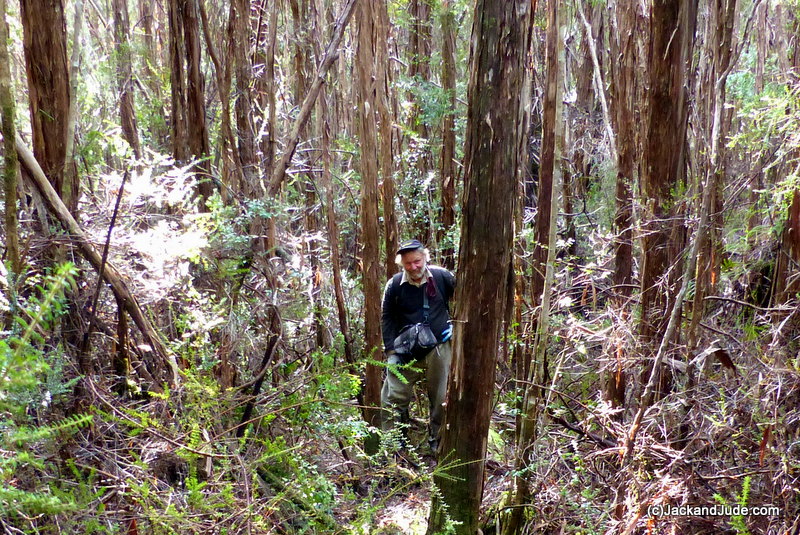


I was totally engrossed with your very well written and vividly descriptive accounts of the two expeditions in search of the “bridge”. Not to mention the magnificent photos. But what teasing bastards you must be not to tell readers why Jack concluded there is no bridge there! Or am I missing something? Please make amends in the next blog. Best wishes for the trip across the strait.
Kevin – Arthurs Seat (when not aboard a sail boat somewhere).